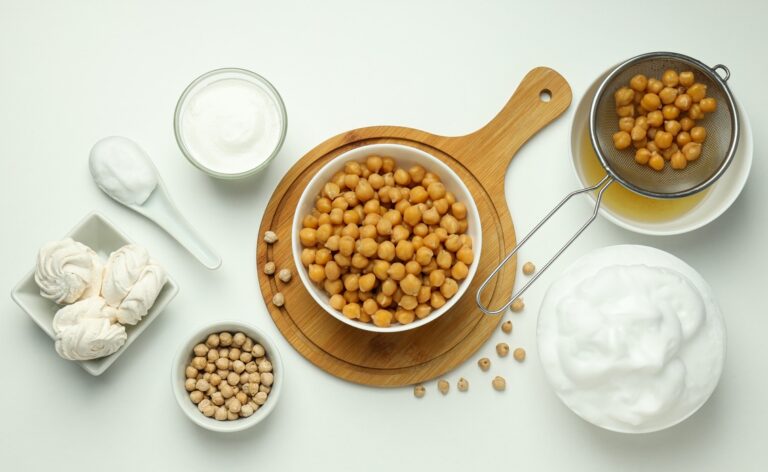If you’ve ever opened a can of chickpeas and poured the liquid down the drain, you’re not alone. That cloudy substance is called aquafaba, and it used to be considered waste by the general population. But in recent years, it’s become a bit of a superstar in the world of plant-based cooking. Once you understand what it can do, it isn’t hard to see why.
The discovery and popularization of aquafaba can be seen as a contribution to modern gastronomy that came directly from the vegan community. By its nature, the world of vegan food is constantly in a state of culinary innovation, seeking plant-based solutions for ingredients traditionally derived from animals. The quest for a perfect egg-white substitute, one that could create stable foams for meringues, macarons, and mousses, was a significant challenge. Early vegan bakers relied on ingredients like flax eggs or various gums and starches, but none could closely replicate the unique properties of egg whites.
Eggs have long been a kitchen staple, especially when it comes to baking. But producing them is an ethical disaster on every level. On the other hand, Aquafaba doesn’t require the farming of hens, and chickpeas are one of the most sustainable crops out there. In stark contrast with the heavy ecological footprint of the egg industry, chickpeas don’t need much water to grow, they improve soil health, and they provide plenty of nutrition with a low environmental impact. Conclusion? When you replace eggs with Aquafaba, you’re making a small but meaningful shift toward a more future-friendly way of eating, while withdrawing your support for the massively exploitative egg industry. When we know better, we can choose better.
The discovery of aquafaba didn’t occur in a corporate R&D lab or a high-end restaurant’s test kitchen. Goose Wohlt, an amateur cooking enthusiast inspired by fellow home cook Joël Roessel, shared his findings on social media. The Facebook group Wohlt created, “Vegan Meringue – Hits and Misses!”, became a global, open-source laboratory. Members from around the world began sharing their recipes, refining techniques, and documenting their results in real-time. This collaborative, community-driven approach accelerated the process of discovery and application far beyond what a single person or company could have achieved.
Aquafaba is now being studied by food scientists to understand its exact chemical composition, in order to optimize its use. From a grassroots, community-based discovery to a subject of scientific research and a tool for professional chefs, it’s remarkable how the vegan movement has influenced the culinary world with this innovation.
What exactly is aquafaba and how does it work?
Latin for “bean water,” aquafaba is the thick liquid you find in a can of chickpeas, or the water left after cooking them from scratch. It might not look like much, but it’s full of plant-based starches and proteins, and it turns out this simple ingredient can act a lot like eggs. When whipped, it traps air, just like egg whites do. And when used in recipes, it binds ingredients together and helps baked goods rise and hold their shape. That means it can be used to whip up meringues, bind burgers, make mayo, bake cookies and brownies, or create foamy cocktails, all without using any animal products.
Aquafaba’s unique ability to mimic egg whites is due to a simple but powerful trio of compounds that leach out of the beans during cooking: proteins, saponins, and carbohydrates. The proteins are key to its foaming ability. When whipped, they unfold and create a stable network that traps air, allowing for the creation of airy meringues and light mousses. Saponins, a type of plant compound with soap-like properties, act as powerful emulsifiers, helping to bind oil and water for creamy mayonnaises and dressings. Finally, the carbohydrates give aquafaba a viscous texture, adding body and structural integrity to everything from baked goods to cocktails.
While aquafaba is most famous for sweet applications, advanced cooks are also using aquafaba in savory dishes. Its ability to emulsify fat and water allows for a variety of creamy sauces and dressings, in addition to simple mayonnaise. Un-whipped aquafaba can be used as a binder in vegan burgers and meatballs, as well as in gluten-free breads and crackers, improving their texture and moisture content. It can also be used as a substitute for egg yolks or oil, which are primarily used for their fat content and ability to add richness. Using aquafaba instead can make dishes like brownies, cakes, and even dressings and condiments lighter and lower in fat while maintaining a desirable texture.
More than just a clever kitchen hack, aquafaba represents a shift toward more thoughtful, more sustainable cooking. One of the main reasons it has caught on is because it makes plant-based cooking a lot more flexible. For a long time, certain foods (like fluffy cakes, marshmallows, and such) were tough to replicate without animal ingredients. But aquafaba broke through the barrier and changed all of that. With a little practice, most people can’t tell the difference. And for anyone avoiding animal products, aquafaba opens up a whole world of tastes and textures.
Aquafaba’s unique composition makes it a subject of research in food technology, and some of these findings are being applied in creative kitchens. Here are some of the many innovative ways aquafaba is currently being used:
1. Advanced Foams, Emulsions, and Gels
• Stable Foams and Meringues: While basic meringues are a well-known use, advanced cooks are creating more complex and stable foams. They are experimenting with different legume liquids (some are more stable than others) and adjusting pH with acids like cream of tartar or even kombu to improve structure and stability. Heating the Aquafaba to a certain temperature (around 175-183°F or 79-84°C) before whipping can denature the proteins, creating a more robust foam that holds its shape better, similar to a Swiss or Italian meringue.
• Savory Foams and Espumas: Just as Aquafaba can be whipped into sweet meringues, it can also be whipped into savory foams to top soups, stews, or even a vegan “frittata” or quiche. This adds a light, airy texture and a unique presentation.
• Gelling: Beyond its foaming properties, Aquafaba has a moderate thickening and gelling ability. It’s being used to create semi-solid matrices in dishes, replacing animal-based gelatin. This is a result of the heat-induced interactions between its proteins and polysaccharides, which form a network structure.
2. Molecular Gastronomy Possibilities
• Spheres and Pearls: The gelling properties of Aquafaba, particularly in combination with other hydrocolloids, are being explored for molecular gastronomy techniques like spherification, which involves creating “caviar” or spheres with liquid centers.
• 3D Food Printing: Aquafaba is being studied as a structure-shaping additive for 3D food printing. Its ability to create stable gels and its unique rheological properties (how it flows and deforms) make it a promising ingredient for creating intricate and precise food shapes.
In essence, the most advanced uses of Aquafaba go beyond simple substitution and delve into more sophisticated applications of its chemical and physical properties. It’s a testament to how creative and innovative vegan cooking has become, turning a once-discarded byproduct into a key ingredient for culinary innovation.
One of the best things about Aquafaba? You may already have it in your kitchen. It comes free with canned chickpeas, which makes it one of the most budget-friendly plant-based ingredients around. There’s no need for expensive egg replacers or fancy health food store items. Aquafaba is cheap, simple, and accessible. And because it’s a byproduct that’s usually thrown away, using it helps reduce food waste, turning something we used to discard into a useful ingredient. That kind of resourcefulness is becoming increasingly important as we all try to waste less and make smarter choices with our food.
Food is personal. It connects us to family, culture, and memories. And for some people, changing what they eat can feel like giving up those traditions. That’s one reason why Aquafaba is so exciting. It lets people recreate familiar recipes without feeling like they’re missing out.
Want to make your mom’s blueberry waffles without eggs? Trying to bake vegan holiday cookies with your kids? Aquafaba makes it easy and accessible all while bridging the gap between comfort food and conscious cooking. The best part is you don’t need special tools or advanced cooking skills to make it happen. While an electric mixer is needed for recipes that require stuff peaks such as meringues, you can start exploring the possibilities with just a bowl, a whisk (or mixer, if you have one), and a can of chickpeas.
Here’s a quick guide:
• To replace one whole egg: use 3 tablespoons of aquafaba
• To replace one egg white: use 2 tablespoons of aquafaba
You can whip it like egg whites for recipes that need fluff and volume (like meringues), or just stir it in for binding and moisture (for recipes like brownies or muffins.) There are tons of recipes online, and if you bake often, once you start using it, you’ll probably find yourself reaching for it again and again.
Aquafaba isn’t just a nifty cooking trick. It’s a reminder that everyday ingredients can hold surprising magic. At the end of the day, aquafaba fosters the notion that we can rethink how we use ingredients, reduce waste, and find joy in making meaningful changes that add up over time. It reminds us that delicious food can come from plants, that you don’t need to sacrifice flavor to eat more sustainably, and that a better way of eating is already in our hands. We just needed to look a little closer at what’s been there all along.

















